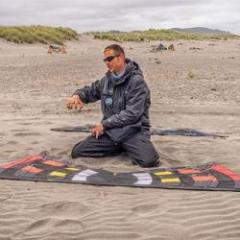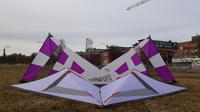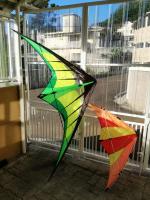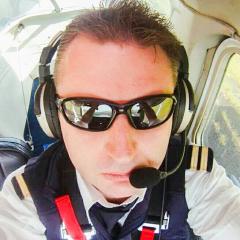Search the Community
Showing results for tags 'beginner'.
-
653 downloads
Another in the ongoing series of Kitelife Magazine tutorials for using Revolution quad line kites, this one detailing how to do maintain a hover in 7 basic orientations.Once you're able to hold a hover with some degree of stability, the sky is yours because you can now stop in any position, and even control your speed when necessary. NOTE: A reliable (and free) cross-platform video player is VLC, which should work with any file format including MKV. Subtitles: English Subtitles: Rev Tutorial - Basic Hover Lithuanian Subtitles: Rev Tutorial - Basic Hover Spanish Subtitles: Rev Tutorial - Basic Hover French Subtitles: Rev Tutorial - Basic Hover Hungarian Subtitles: Rev Tutorial - Basic Hover- 3 reviews
-
- 2
-

-

-
- stationary
- subtitles
-
(and 2 more)
Tagged with:
-
400 downloads
Another in an ongoing series of Kitelife Magazine tutorials for using Revolution quad line kites, this one detailing the assembly and disassembly methods used by Team iQuad out on the field, at over one hundred festivals worldwide since 2006. While putting your kite together and taking it apart may not be relevant to your flying, it DOES effect not only the longevity of the kite and its materials, but a proven process can greatly streamline and simplify your "before and after" on the field. NOTE: A reliable (and free) cross-platform video player is VLC, which should work with any file format including MKV. Subtitles: English Subtitles: Rev Tutorial - Assembly and Disassembly Japanese Subtitles: Rev Tutorial - Assembly and Disassembly German Subtitles: Rev Tutorial - Assembly and Disassembly Lithuanian Subtitles: Rev Tutorial - Assembly and Disassembly French Subtitles: Rev Tutorial - Assembly and Disassembly Dutch Subtitles: Rev Tutorial - Assembly and Disassembly Spanish Subtitles: Rev Tutorial - Assembly and Disassembly Portuguese Subtitles: Rev Tutorial - Assembly and Disassembly Thai Subtitles: Rev Tutorial - Assembly and Disassembly Hungarian Subtitles: Rev Tutorial - Assembly & Disassembly -
374 downloads
Another in the ongoing series of Kitelife Magazine tutorials for using Revolution quad line kites, this one detailing how to make and apply a larks head knot. Aside from being the sole way most lines are attached to kites and handles these days, it's an extremely handy knot for a variety of purposes. NOTE: A reliable (and free) cross-platform video player is VLC, which should work with any file format including MKV. Subtitles: English Subtitles: Rev Tutorial - Larks Head Knot Spanish Subtitles: Rev Tutorial - Larks Head Knot Japanese Subtitles: Rev Tutorial - Larks Head Knot French Subtitles: Rev Tutorial - Larks Head Knot Hungarian Subtitles: Rev Tutorial - Larks Head Knot- 1 review
-
- 2
-

-
- subtitles
- attachment
-
(and 3 more)
Tagged with:
-
434 downloads
Another in an ongoing series of Kitelife Magazine tutorials for using Revolution quad line kites, this one detailing the 180 - an essential team flying skill that becomes more stable with the application of positive drive. NOTE: A reliable (and free) cross-platform video player is VLC, which should work with any file format including MKV. -
334 downloads
This tutorial explains some of the dynamics of line weight and length selection on Revolution kites This is one of those topics where there is no right way, and we hope the information contained in this video help you experiment and find your own favorite(s). NOTE: A reliable (and free) cross-platform video player is VLC, which should work with any file format including MKV. -
530 downloads
Full tutorial detailing the line winding and unwinding methods developed by John Barresi and Team iQuad out on the field, over the course of over one hundred festivals worldwide since 2006. One of the recurring issues we've heard from Rev fliers, especially newer pilots, is the frequency of twists and tangles when folks set up their kite to fly but using this method correctly, any flier can set up in 3-5 minutes without fail and roughly the same to pack up at the end of the day. NOTE: A reliable (and free) cross-platform video player is VLC, which should work with any file format including MKV. Subtitles: English Subtitles: Rev Tutorial - Line Management Japanese Subtitles: Rev Tutorial - Line Management German Subtitles: Rev Tutorial - Line Management Lithuanian Subtitles: Rev Tutorial - Line Management Chinese Subtitles: Rev Tutorial - Line Management French Subtitles: Rev Tutorial - Line Management Dutch Subtitles: Rev Tutorial - Line Management Spanish Subtitles: Rev Tutorial - Line Management Portuguese Subtitles: Rev Tutorial - Line Management Hungarian Subtitles: Rev Tutorial - Line Management -
Basic question here is what would be a good age and most important SAFE age and weight to get into kite sports? He will be 8 years old 2 week in August 2020. He is adventurous, average build, fairly smart and sensible. He is now 60 Lbs/27 kilos but has never flown kits before and I was thinking of getting him some form or entry training kits he could learn to fly rather then get pulled. Also these kinds of kits unlike the average toy shop one tend to be easy to launch. But I want him safe, not terrified or hurt and not to put his protective mum (ie sis) off this so need her happy too even if the lad is shouting out 'weeeeeeeeeee' with glee going airborne on his first go, that would mean no more kite and moi in the doghouse. We need to get mum on side here at least long enough for her trust us from the cafe Initial investigation has pointed to 2 Kits. The Cross Kits Air 1.2m £25 or 1.5m £35 (Thinking 1.8 is pushing luck with a 27 kilo 8 year old rookie ) Or the HQ4 Fluxx 1.3 Trainer Power Kite £49-£59 + £8 for the safety system The HQ4 Flux comes with a control bar with the option to get HQ Rush Safety System Wrist strip which looks to be a form of kite killer. The HQ Flux looks a better bt to me due to the bar which is more like what later kites will use so good for practice and I like the Safety system strap but its double the price, Im unemployed and I dont know how much use will be had out of said kite Its likely this would be used when Im not around ie mum or dad taking him, neither of whole have any kite experience as far as I know. So it needs to be suitable for rookies and as said we are talkign a very light weight clueless 8 year old boy here. Ie he too young, to small and light? Would either of the above kites be fine and is the HQ flux worth double the price? Also which would be better the 1.3 m or 1.5m or is or too small a difference to notice. This is likely to be used in the local park or fields as he is on the edge of town, in fields / parks surrounded by trees. Not expecting much wind Have also had a look at the HQ Symphony 3 1.3m kite which looks very similar to the Cross air 1.3m. can you guys advice please? It appears to be do I go for the Cross Kite air with the hand loops or the BQ4 Fluxx 1.3 meter kite with control bar and a safety wrist leash kite killer strap. This loops a bit better but is double the price. Is it worth it? Was told to add this.... Where are you? London Where do you fly? (or want to) Parks in North London - Trent Park, Bush Hill Park, in North London, Also Alexandra Palace, Finsbury Park etc What kiting experience do you already have?Its not for me, i have had a little experience with a Flexifoil 3.5m bullet. I am asking for my nephew who is aged 8, 60 ponds, 27 kilos and never flown any kite its not for me. I have had experience with a 3.5 m flexifiol Bullet.. This is to train an 8 year old who has never flows any kite. First kite to introduce and give him a taste, he could build from What aspect of powerkiting are you interested in? (Buggying, Landboarding, Snow Kiting Kite Surfing, Jumping, etc..) Training an 8 year old who has never flows any kite. First kite to introduce and give him a taste, he could build from What are your local winds like? (Averages, gustiness etc.): Very Low How much do you weigh? (Not trying to be personal, Bigger people are less likely to be overpowered by marginally bigger kites and most of us want to start you on a kite that will teach you without hurting you.) We are talking a possible present for a 60 lb / 27 kilo boy for his 8 year old birthday What kind of budget are you looking at? (just to narrow choices) £25 - £55
-
519 downloads
Another in the ongoing series of Kitelife Magazine tutorials for using Revolution quad line kites, this one detailing how to equalize your lines, ensuring equal length between right and left.All types of line stretch or "settle in" over time and will eventually end up uneven by varying amounts which effects the accuracy of your inputs accordingly... You'll be amazed at how the kite responds more accurately, and how easy it actually is to balance out your line lengths. NOTE: A reliable (and free) cross-platform video player is VLC, which should work with any file format including MKV. Subtitles: English Subtitles: Rev Tutorial - Line Equalizing Lithuanian Subtitles: Rev Tutorial - Line Equalizing Spanish Subtitles: Rev Tutorial - Line Equalizing Japanese Subtitles: Rev Tutorial - Line Equalizing Hungarian Subtitles: Rev Tutorial - Line Equalizing French Subtitles: Rev Tutorial - Line Equalizing -
Hi so I am new here and I currently fly a prism E3 and have a decent amount of dual line experience. I saw revs and I knew I had to get one for summer break. But I am really not sure which one to get. I would like one that I can learn on and then move up to a-lot more advanced things. I really want the full experience. I have never owned or flown a rev before and any advice is greatly appreciated. Thanks - Jake
-
3/4 of a year ago my old time kite guru from the end of the nineties, @Anders Matson, suddenly surfaced on KiteLife and back "into existence" (a very subjective statement on my side) last summer after say 18 years. Anders lives on the west coast, while I live on the east coast (of Sweden i.e.). About a month ago he kindly sent me an animation and an illustrated document describing a QLK kite routine and when I asked he allowed me to share them (they are attached at the end of this post). The kite routine will be performed as a part of the 20th anniversary celebrating Nordic Kite Meeting ( http://kites.aerialis.no/its-getting-closer/ ). This meeting will coincide with the Blokhus - Lökken wind festival on the north west coast of Denmark ( https://www.facebook.com/BlokhusLoekkenWindFestival/?hc_location=group ). This is how I, an absolute quad team (sub-) rookie, approached the routine documents. As there are no serious (non power) kiters around me I had to practice this without a team. In fact, there a no other framed QLKs in this part of the country that I know of and the only framed QLKs I have ever seen are my own. I got the first one, a Rev. B-series 1.5 Std., in June 2017. My two months of intensive QLK started out a month later. This intensive training period was due to (should I really say thanks to?) the missed JB QLK-clinic that happened to take place reasonably geographically nearby (in Denmark), which to my knowledge never has happened before. Feeling frustrated, I set out a goal to at least compensate through intensive practice for this missed opportunity of learning - I raced against imaginary fellow QLK pilots and stopped doing DLKs for the duration of this period. Not until that point that the clinic was over did I return to do DLKing again or rather from that time I did both disciplines. Some remaining questions: What are the most common beginner difficulties? Are there any other things that I missed preparing for (see further down below)? Are there standard routines that are well known and spread so that people can be more prepared for spontaneous formation/team flying at festivals? Where can you today find advice on getting stated (other than the below). Is there a standard vocabulary that a "skipper/captain"(?) would use (talk/shout) when coordinating a group? Initial impression/digestion of the routine description After going through the Anders Matson routine material several times, I realized that I needed to to work with the material in some way to remember it more easily. I looked for sequences that were/could be grouped together and found that the landings formed natural start and endings of the sub sequences. There are several landings in the routine. I believe that this matches well with the designers intention of the routine to be inclusive and allow reasonably skilled QLK pilots to join in, since the landings should serve to collect and synchronize the group (I believe). Even if it has been designed to be available to everyone that can control a QLK, it is certainly not the case (IMO) that you can do this well without practicing. Below is a condensed terse form of the routine that Anders sent me. It contains much of the info, but not everything and is therefore not "stand alone" from the other attached documentation.: Abbreviations RHS Right hand side LL Landed line HL High line CCW Counter clockwise FYK Follow your kite. This will prevent that the kite lines (kite to kite i.e.) get twisted around each other. CW Clockwise ML Mid (height)line OL Offsetted line - the right half is at 60% of wind window and the left is at 40% height. GRID A kite double line - two rows and several columns RSRP Rotate step rotate pause: From horizontal pos. turn 90deg to side, wump sideways one step, rotate 90deg to horizontal. When reaching an end of the line, drop or rise vertically with the LE remaining in orig. direction. The pace of this part is: And rotate, and step, and rotate, and pause WGRID Widen grid The Routine LL - Repeat 4: WAVES(fr. RHS) - LL Repeat 2: LL - ARCHES - LL LL - Repeat 2: CIRCLES(fr. RHS, CCW, FYK, LE forward) - LL LL - ML - OL(FYK +/-2step, form CCW) - GRID - OL - GRID Repeat until orig pos. (CW, FYK): RSRP WGRID HL - LL or shorter LL - Repeat 4: WAVES - LL Repeat 2: LL - ARCHES - LL LL - Repeat 2: CIRCLES - LL LL - ML - OL - GRID - OL - GRID 1 lap: RSRP WGRID HL - LL or even shorter 4 WAVES 2 ARCHES 2 CIRCLES ML 2 (OL,GRID) 1 lap: RSRP HL Mental images for avoiding line tangles The largest worry of managing to do the routine well was flying with others and this thing about getting the lines tangled - the flight pattern of the kite was something that I could practice. Simply how did the line thing work when flying in a team? Anders had clearly drawn how the pilots should move on the ground, but it didn't feel like it was a good general way to just memorize it. I therefore sought a model that one can "always" apply. First I imagined that the pilots movements were an in the horizon mirrored image of the kites movements. That was a valid image but was to complicated for me to to function in real time when practicing the routine. The next picture I made to avoid line tangle was to follow the shadow of the kite on the ground (provided that it was a back lit kite). This was easier to remember. After the second routine training session I narrowed it down to just follow your kite (sideways). The down wind/up wind (ground) movements didn't need a mental image. It is intuitive - when you want the kite to go down you walk towards it when you want it to rise you walk backwards. Line set choice, handle adjustments and general wind challenge identification First action to get prepared for the event was to start using the (completely?) unused 40m line set, since Anders recommended 35m to 40m lines for the routine. Handling this new line gives me Climax (the line manufacturer i.e.) yellow left index finger tip when winding the line set up. The so far three 40m line practice sessions I have had here revealed some wind related possible problems. If the wind dips and/or there is ground turbulence, keeping the place of the kite in the (imagined) formation became difficult without much upstream movement/backing. To create more margin I moved the larks head in from the outermost position on the top leaders a couple of knots closer to the middle of the knot range. I imagine that one easily could cause disorder in the team if some of the members started to run backwards. I expect that the first ones to run backwards are those whose kites are lowest in the formation, because the wind is typically lower there. When they try to back the other pilots might not have the same need, because they got more wind as the kites are higher up. On the other hand, in the upper part of the wind range the challenge is another one. There maintaining position or a stable slow pace in the strongest gusts in a carefully planned way was the challenge. Nowadays I don't mind making a mixed DLK/QLK session as in this image from my latest session to prepare for the routine. I believe it increases the over all efficiency if one aims to progress in both types of kiting. I also think that the colours of my 1.5 B-series mid vent and my Level One Oneleven match very well. Drills related to the routine General The stand by position of a quad IMO is inverted. It is the easiest position to hover the kite in light wind. For me (and for many others I assume) it is also the stable position that minimizes any kite movement. Compared to any other hover, the inverted just looks best for me. It doesn't stop there, I see the inverted slides as the easy one and most often end up doing this rather than the non-inverted. This means it makes sense to practice the very basic regular hover since the routine is 100% free of any inverted hovers and other inverted moves. The waves and the arches Not much to say about flying forward and up. What requires some practice is to fly backwards and down as fast as possible in some possibly turbulent winds without having the kite wobbling. The circles Initially I assumed that you flow the circle much like a DLK. It was then quite straight forward, only the part around "07:30" in the CCW circles needed some finishing. Then during a mid vent session in a high wind period not really suited for the mid vent I dropped the assumption that the kite was choosing the speed and then more slowly positioned the kite along the circle. Now it became a challenge and a more thorough preparation for the event. The formation, execution and end of the grid This is the most challenging part, both in complexity (to remember) and skill of kite moves required. Apart from memorizing the paths/patterns, several things needed practice here: The snappiness of the 90deg clockwork like rotations. Maintaining the height in turbulent winds when being in the lower row of the grid. Doing the vertical slide upwards quickly (I originally thought this was very necessary and the single most demanding part). Keeping track of the four steps (backward/forward) required when doing the vertical slides. I have not been happy with my clockwork's snappiness. Now it is high time to start working on it. If one use flicking movements of the (lower side of the) handle. Then the kite movement will be snappy as well. If you inputted the right amount of start and stop movement of the handles you just made as successful snappy 90deg kite rotation. Still working on reliably avoiding wobble here. My first idea of the pace of the steps (the above RSRP) of the grid was a 1-2 or a 1-2-3, but Anders informed me that it was much slower: and rotate, and step, and rotate, and pause. When thinking the 1-2 or the 1-2-3 option was the case, I saw it as a problem to be able to do the vertical slide upwards quickly enough. Speed of the upwards vertical slide might still be required so this is something I practice. So a general rule of thumb to counteract the DLK steering effect when setting the left/right kite angle to drive the kite sideways (in the direction of the LE) is to add to LE angle by twisting the left/right handles in opposite directions. In other words, enhance the LE slide angle (that is set by extending one arm) by twisting the handles relative to each other. Pretend that you have the top of the handles connected with a rubber band that you want to stretch as much as possible by adding a twist to the handles. Being aware that this is what you do in a slide to maintain the orientation of the kite, enabled me to exaggerate hand movements/positions and run upwind and still keep the kite orientation in the upwards slide. To make my muscles remember this I did an exercise. I let the kite do an upside down "U" while sliding from left to right and keeping the LE pointing outwards. In the straight parts of the "U", both up and down, angle the top of the handle that you keep closest to you so that the handle top comes even closer to you, while on the extended arm angle the top of the handle from you. In the curved part of the upside down "U" reduce the relative twist of the handles. The second exercise I had that was related to the grid was also geared towards the vertical slides. I pretended the team consists of two or four persons so that the part of the time I did the vertical slides increased. The steps of the grid was then repeated over and over and over. After the latest training session I came to the realization that this art sometimes requires a sacrifice. Finally, before publishing this post I got the bright idea to read what other experienced pilots have written: https://web.archive.org/web/20060127225614/http://www.kitelife.com:80/archives/SEPT991/team.htm http://www.rehilliard.net/pdf/AKATeamFlyingManualbyTroyGunn.pdf (thanks again A. for the link) http://kitelife.com/1998/05/01/issue-2-beginning-ballet/ http://kitelife.com/1998/06/01/issue-3-team-basics/ Ouch, there were many issues with coordinating with others in the above links, this is a bit hard to do on your own. Perhaps I'll try to do the mini kite on a stick anyhow to rehearse the routine (for the event above) as also recommended in the links above. Perhaps it is more efficient for learning than the compressed terse text form is? But on the other hand, writing/reading text during a public transportation ride doesn't look funny, while waving a stick kite could. In an unrestricted wish list, there would be an online common stick practice simulator with verbal communication option, so that at least that aspect of team flying without distant travelling could be covered. Perhaps a (sub set of a) FPS like WASD/mouse control input for controlling your online kite? Rev rutin BLOKHUS.mp4 NKM2018Revrutin.pdf
-
Version 1.0.0
17 downloads
This tutorial from Kitelife.com breaks down some of the technique that goes into rotational control on most indoor dual line sport / stunt kites. You can look forward to a growing collection of similar tutorials covering equipment, flight techniques and other "pro secrets" gathered from over 20 years in the kiting community... A number of them will be available here on YouTube, while the majority of these tutorials will be located in the Kitelife Subscribers section, be sure to subscribe today if you like what we're doing here! -
Version 1.0.0
19 downloads
This tutorial from Kitelife.com breaks down the basic method for a few types of launches on most indoor dual line sport / stunt kites including the super cool fade toss. You can look forward to a growing collection of similar tutorials covering equipment, flight techniques and other "pro secrets" gathered from over 20 years in the kiting community... A number of them will be available here on YouTube, while the majority of these tutorials will be located in the Kitelife Subscribers section, be sure to subscribe today if you like what we're doing here! -
Version 1.0.0
15 downloads
This tutorial from Kitelife.com breaks down the basic method for a simple launch and 360 maneuver on most indoor dual line sport / stunt kites, including crucial information about radius and stride. You can look forward to a growing collection of similar tutorials covering equipment, flight techniques and other "pro secrets" gathered from over 20 years in the kiting community... A number of them will be available here on YouTube, while the majority of these tutorials will be located in the Kitelife Subscribers section, be sure to subscribe today if you like what we're doing here! -
Version 1.0.0
16 downloads
This tutorial from Kitelife.com breaks down the basic method for the Up & Over maneuver on most indoor dual line sport / stunt kites. You can look forward to a growing collection of similar tutorials covering equipment, flight techniques and other "pro secrets" gathered from over 20 years in the kiting community... A number of them will be available here on YouTube, while the majority of these tutorials will be located in the Kitelife Subscribers section, be sure to subscribe today if you like what we're doing here! -
Version 1.0.0
13 downloads
This tutorial from Kitelife.com breaks down an efficient and reliable disassembly method for most indoor dual line sport / stunt kites. While putting your kite together and taking it apart may not be relevant to your flying, it DOES effect not only the longevity of the kite and its materials, but a proven process can greatly streamline and simplify your "before and after" on the field. You can look forward to a growing collection of similar tutorials covering equipment, flight techniques and other "pro secrets" gathered from over 20 years in the kiting community... A number of them will be available here on YouTube, while the majority of these tutorials will be located in the Kitelife Subscribers section, be sure to subscribe today if you like what we're doing here! -
Version 1.0.0
23 downloads
This tutorial from Kitelife.com breaks down an efficient and reliable assembly method for most indoor dual line sport / stunt kites. While putting your kite together and taking it apart may not be relevant to your flying, it DOES effect not only the longevity of the kite and its materials, but a proven process can greatly streamline and simplify your "before and after" on the field. You can look forward to a growing collection of similar tutorials covering equipment, flight techniques and other "pro secrets" gathered from over 20 years in the kiting community... A number of them will be available here on YouTube, while the majority of these tutorials will be located in the Kitelife Subscribers section, be sure to subscribe today if you like what we're doing here! -
Version 1.0.0
14 downloads
This tutorial from Kitelife.com breaks down basic tuning methodology for most indoor dual line sport / stunt kites. You can look forward to a growing collection of similar tutorials covering equipment, flight techniques and other "pro secrets" gathered from over 20 years in the kiting community... A number of them will be available here on YouTube, while the majority of these tutorials will be located in the Kitelife Subscribers section, be sure to subscribe today if you like what we're doing here! -
Registration for one person, provides full access to instruction at this fun and educational workshop covering the most important aspects of QUAD LINE flying on The Flats in South Padre Island TX (capped at 20 students total) following the SPI Kite Festival. Exact location https://goo.gl/maps/Wf5NZPu4wfo Skill levels from first time flyers all the way up to masters are welcome, there is content for everyone and four instructors (ratio of 5 to 1) available all day including Team KiteLife members John Barresi, Scott Benz (@mystainedskin), Eli Russell (@windpoacher) and Brett Marchel (@Flight Risk). Schedule is 10am to 4pm - we cover an incredible library of important fundamentals in the “Quad 101” starting presentation, so please do be on time and consider something for taking notes - this is also a bring your own kite affair, but all types are welcome. We will break for a one hour lunch around noon, but some of the instructors will still be on the field assisting with remedial skills. By early afternoon we should be introducing folks to how easy team flying can be with a little information and understanding of how it all works - those who feel ready will also participate in a mega fly all together... NOTE: Team flying participation does require 120’ length lines and a 1.5 comparable kite of any brand. Signed up so far: @chucka @frob == Signup link http://kitelife.com/forum/store/product/72-tkl-clinic-spi-quad-line-feb-4th-2018/ Registration fee - $80
-
Hi all. This a continuation of my introduction thread found right here Basically I'm a new flyer who had a paimpol expresso, just got a prism hypnotist (haven't got it in the air yet) and just asking questions around So my latest inquiry is: Is there a noticeable difference between a brandname dyneema line like the one sold by prism and a dyneema line sold on ebay? (I know dyneema is a brand name. but you get what i mean). and just because: here's a pic
-
Hello! My name is Jason, I am from Melbourne Australia. I was recently introduced to a 2 line stunt kite by my brother in law, and I was hooked! I did some research online and am now the proud owner of a Prism Quantum and a 75 foot tube tail. I have had a few outings with it already, and I am sure you are probably not surprised to learn that I am already waiting on replacement center T as a result of some high speed soil samples. So in the meantime I was hoping for some advice and suggestions! What would you consider "must have" accessories? Is there a list of stunts or some sort of order that I should start learning them in? Good online resources for said stunts? (other than this one!) General tips and tricks for total noobs? Relating to the Quantum: Any suggested mods, tips or tricks? What parts are most prone to breaking? Thank you in advance! Jason.
-
Hello! I am looking for a first dual line kite. I have no experience, but could always get those those old plastic grocery store kites to do loops, etc. I've been looking a bit and I thought that Prism Nexus looked like something that could take me from beginner into entry-level intermediate. After reading on the forums, I'm not so sure. I'm in the Midwest in the USA, so wind can be a problem, but there's lots of open space in which to fly! Looking for thoughts, recommendations, and maybe even someone who has a great used beginner kite for sale! I appreciate any advice and direction you're willing to provide!
- 11 replies
-
*****EVENT CANCELED***** This workshop is specifically tailored for first time, beginner and intermediate quad fliers who want to try their hand at team flying - if you're able to launch, hold a basic upright hover for a few seconds, fly a little left, a little a right and back down to the ground (land), you're ready for this class! It is strongly suggested that you have attend (or have attended) one of our past Quad Clinics or Rev 101 sessions, as there is key equipment knowledge (set up, etc) that really should precede team flying. Fliers MUST bring 120 ft lines to participate, as team flying requires everyone to be on matching length lines. Registration is $175 per person ($150 for KiteLife Subscribers) to participate over the full weekend of learning. Schedule is 10a-4pm on both Saturday and Sunday. == KiteLife Subscriptions - http://join.kitelife.com/ == Fliers bring their own equipment, and we do generally break for lunch in the middle of the day - DO bring some rain gear in case we get sprinkled on. Before then, I strongly encourage you to browse these FREE video tutorials for some pre-workshop study... Hope to see you there!
-
474 downloads
Another in the ongoing series of Kitelife Magazine tutorials for using Revolution quad line kites, this one detailing two basic methods for relaunching a Rev from the flat belly down position, leading edge away or toward you.Being a two-dimensional kite when not under power, the Revolution can be a little tricky to relaunch when it's flat on the ground but with these simple techniques, it's generally no more difficult than flipping over any other kind of sport kite. NOTE: A reliable (and free) cross-platform video player is VLC, which should work with any file format including MKV. Subtitles: English Subtitles: Rev Tutorial - Flat Relaunch Japanese Subtitles: Rev Tutorial - Flat Relaunch Chinese Subtitles: Rev Tutorial - Flat Relaunch Lithuanian Subtitles: Rev Tutorial - Flat Relaunch German Subtitles: Rev Tutorial - Flat Relaunch Spanish Subtitles: Rev Tutorial - Flat Relaunch Dutch Subtitles: Rev Tutorial - Flat Relaunch Portuguese Subtitles: Rev Tutorial - Flat Relaunch French Subtitles: Rev Tutorial - Flat Relaunch Thai Subtitles: Rev Tutorial - Flat Relaunch Hungarian Subtitles: Rev Tutorial - Flat Relaunch -
I purchased a Rev 1.5 SLE back some time ago. There is a long list of thinks that kept me from flying it. But glad to say I'm leaving for the beach in the morning and it's packed in the truck. I've watched all of the training videos on the Rev kites but I don't seem to find anything about the first launch for a beginner quad person. So my first question is do you try to start inverted with the handles staked like the gentleman shows in the line management video and make the kite roll over, or set it in the upright position with the top leaning back to keep it on the ground? My second question is how do you know that you have the correct setup at the handle? Example how do you know you have the line length at the top and bottom correct? Is there a neutral position? Thanks in advance for your help!
- 12 replies
-
- rev
- revolution
-
(and 3 more)
Tagged with:
-















